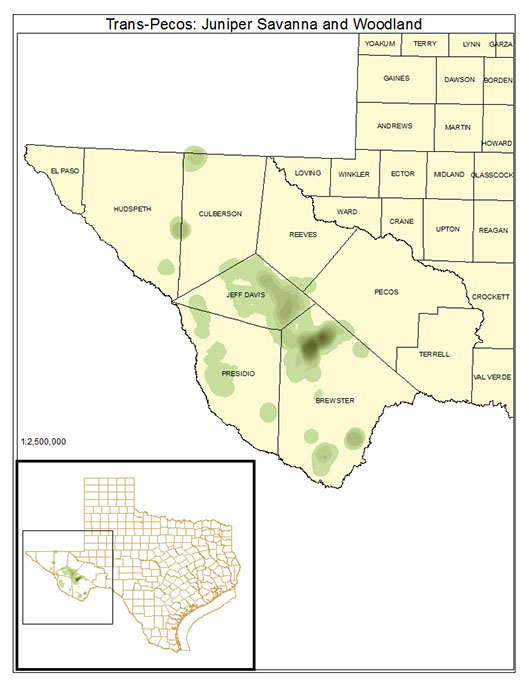Madrean Juniper Savanna
Geology
Associated with various substrates including limestones, sandstones, igneous formations, and alluvial/colluvial surfaces.
Landform
This system typically occupies foothills and lower slopes of mountains. Such situations may often be rolling landscapes, and are sometimes on gentle slopes to level surfaces.
Soils
The soils occupied by the system vary from gravelly, to shallow to loamy soils. It may also occur on rocky slopes of limestone or igneous parent material.
Parent Description
This system often co-occurs with the Madrean Pinyon-Juniper Woodland, but often occupies slightly lower elevations. It is similar to that system but lacks pinyon as a dominant, though some pinyon species (Pinus cembroides (Mexican pinyon pine), Pinus edulis (pinyon pine), or Pinus remota (paper-shell pinyon pine)) may be present. One of several juniper species may be the dominant overstory, including Juniperus monosperma (one-seeded juniper), Juniperus pinchotii (redberry juniper), Juniperus coahuilensis (rose-fruited juniper), or Juniperus deppeana (alligator juniper). The system may occur with junipers forming a shrubland, or as a closed woodland, or, more commonly, as an open woodland. Nolina texana (Texas sacahuista), Dasylirion leiophyllum (smooth sotol), and Yucca spp. (yuccas) are commonly encountered. This system typically gives way at lower elevations to grassland, with species such as Bouteloua gracilis (blue grama), Bouteloua curtipendula (sideoats grama), Bouteloua eriopoda (black grama), Muhlenbergia emersleyi (bull muhly), and Muhlenbergia setifolia (curlyleaf muhly) commonly encountered in the herbaceous layer.
Ecological Mapping Systems
Trans-Pecos: Juniper Savanna and Woodland
As described for system.
Distribution Map

Photos

Public Land Occurrence
- Big Bend National Park: US National Park Service
- Big Bend Ranch State Park: Texas Parks & Wildlife Department
- Black Gap Wildlife Management Area: Texas Parks & Wildlife Department
- Davis Mountains State Park: Texas Parks & Wildlife Department
- Elephant Mountain Wildlife Management Area: Texas Parks & Wildlife Department
- Fort Davis National Historic Site: US National Park Service
- Guadalupe Mountains National Park: US National Park Service